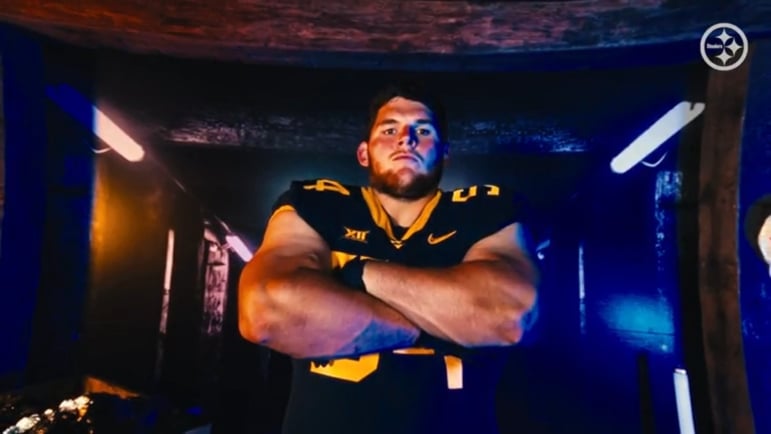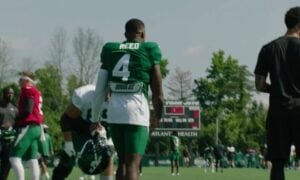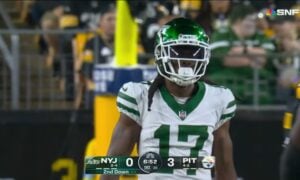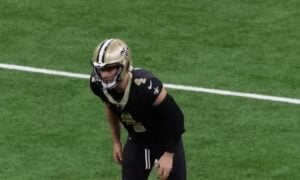I, like many, choose to view most draft picks with an optimistic lens. Or at the least, explain what they’re capable of doing as opposed to what they’re not. Every prospect comes with pros and cons and overall, we explain both. But it’s slanted towards their strengths because it’s fun to talk about how a player might help the team succeed.
Now that we’ve discussed the pros of the Pittsburgh Steelers’ seven draft picks, let’s put the shoe on the other foot. A focus on the biggest problem and concern with each pic. To be abundantly clear, this is not an overall evaluation of their game. It’s a purposeful critique of each prospect since that side is talked about less often.
OT Troy Fautanu: Lunge/lean + Position Switch
It was a little tough to come up with a negative mark on Fautanu, a talented and well-rounded prospect overall. It’s why he was the Steelers’ first-round pick. On tape, there is a bit of forward lean and lunge to his game, specifically in pass protection. Lack of length isn’t the issue, his arms are nearly as long as Broderick Jones’, but perhaps an overall smaller frame compared to some defensive ends is causing him to lunge a bit. He may have to stop using his dead/bait hand in pass protection, which can mess with the placement of his punch and a technique o-line coach Pat Meyer generally doesn’t like his guys to use.
More obvious is a potential/likely position switch. He worked at right tackle throughout rookie minicamp, suggesting the team will flip him and put Jones back on the left side. Fautanu played right tackle in high school and says he’s comfortable over there, but it will be a transition. Protecting a left-handed quarterback in college might ease that move a bit but he’ll still have to step and punch with the opposite foot and hand. I’m less concerned here but it will be a Year 1 adjustment among the many others rookies face.
C Zach Frazier: Lower Ceiling
Getting Frazier in the second round was strong value and filled a key need. But I’m not expecting him to become the next Maurkice Pouncey. He’s just not that type of athlete with that kind of movement. It shouldn’t create limitations for the Steelers’ run scheme, but Frazier’s upside isn’t overwhelming. He was drafted because he’s solid, steady, and highly experienced.
More technically and specifically, he’ll have to be more aggressive in pass protection. He catches too often and power rushes put him on his heels. It’s not an issue I’m terribly concerned about but a minor adjustment I noted in my scouting report months before he was drafted.
WR Roman Wilson: Lack Of Size And YAC
Wilson is a strong and solid route runner with plus hands but there are some serious issues with his game beyond even the lack of outside work I’ve harped on. Wilson’s frame is slight, and he’ll have to work his hands and releases to beat press. He’s fast but Wilson’s YAC isn’t there, data backed up by Clayton Eckert’s recent study. To be a receiver without great size or YAC isn’t an awesome combination and could pose problems for his big-play ability and consistency at the next level.
ILB Payton Wilson: Block Deconstruction
Medical concerns are an obvious and well-documented concern. I won’t rehash it. Focusing on the field, Wilson’s tape was fun, and his great testing perfectly matches his tape. In the run game, he’s aggressive, makes plays, and keys the ball well, but I thought he needed to do a better with his hand use and block shedding. Too often, he was going around or spinning off blocks to defeat them instead of staying square and using his hands. His arm length is poor, just 30.5 inches, and that creates some problems for him against base blocks. He’ll need to be more technical at the NFL level where his athleticism alone won’t cut it.
OG Mason McCormick: Footwork
If there’s one pick I’m worried about not because of a lack of physical tools but the NFL transition, it’s McCormick. Coming from South Dakota State means a jump in competition but it’s low-hanging fruit and I don’t think he’ll be overwhelmed by the NFL. He’s experienced, humble, and smart – he knows what it takes to compete at a high level.
What I’m worried about is his footwork. We’ve already covered the technique change he’ll have to make with one of his calling cards. Pulling. From skip pull to square pull, it’s something he can tweak but will be a change. More broadly, my concern is twofold. The larger footwork changes he’ll have to make under Pat Meyer. Aggressive sets, flat or forward for a lineman who is bigger and broader and not twitchy for the position in terms of lateral movement. That’s a challenge for all linemen who play under Meyer, but Fautanu is more agile, Frazier more technical.
While McCormick tested as a fantastic athlete, it didn’t carry over to his tape. He has foot speed and it’d be unfair to call him a lumberer, but he struggled to hit moving targets and redirect at the second level off combo blocks. Something he’ll do plenty of in Arthur Smith’s system. I can see plenty of preseason struggles and inconsistency with McCormick’s game.
DL Logan Lee: Defining Physical Trait
Lee got my vote as my least favorite selection. To his credit, he’s a high-effort player who runs to the ball with urgency. But on tape, I didn’t identify many other standout traits. He has some strength but is an average/below-average athlete who struggles to finish as a pass rusher. When asked to two-gap in the run game, he can play high and get washed and a lack of length hurts him in all areas. Doesn’t create space in the run game, getting too chest to chest with the blocker, and isn’t able to land his first punch as a pass rusher. That causes him to counter to win, which slows him down. He’s a sixth-round pick, sure, and expectations are relative but even Day 3 players can have at least one standout physical trait. I didn’t see it with him.
DB Ryan Watts: Position Fit + Lack Of College Production
An obvious one to round out the list. Is Watts a corner, a safety, some sort of hybrid? That’s what the Steelers will have to figure out and sixth-round picks don’t get as much time or reps as a Day 1 or 2 prospect. Hopefully, his traits to play on special teams can buy him time and fill a role. Questions over his long speed had some draftniks considering him a safety, a position he played in the East-West Shrine Bowl. On tape, Watts is a grabby corner who must find a better balance of using his length and playing clean, panicking when the receiver gains a step. Penalties are a potential problem.
Beyond that, a lack of college production is concerning. Over his two years at Texas after transferring from Ohio State, Watts recorded just six pass deflections and one interception. If he struggled to make splash plays in college, it’s going to be hard to be more productive at football’s highest level. Concern








